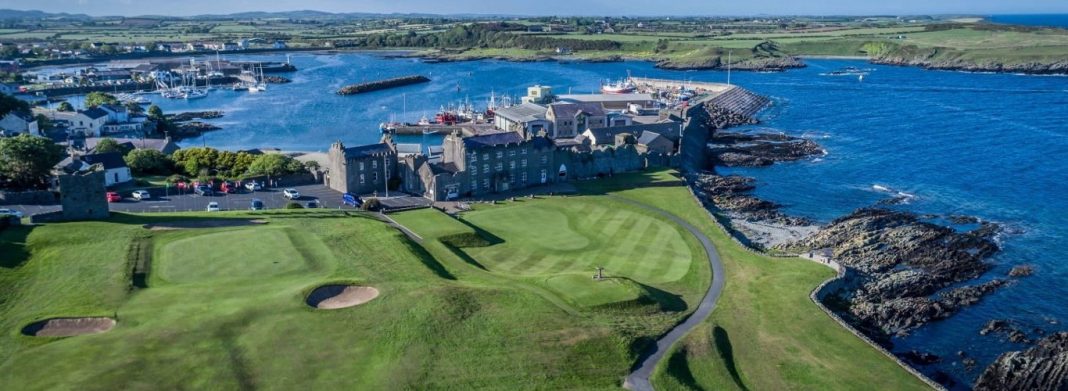Standing on the first tee at the historic Ardglass Golf Club, the entire island of Ireland sits to your right. Aim for Sligo, I was told. Just don’t go left.
The golf proved a mere distraction as the next four hours were filled with views of the rugged and beautiful coast line from every hole with the majesty of the Mourne Mountains providing the perfect back-drop.
The course hugs the coast, with no fewer than eight holes where the Irish Sea coastline comes into play. In fact, the Irish Sea is visible from all 18 tees and greens and on a clear day it is possible to see across to the Isle of Man.
And just up the road from Ardglass – less than an hour from Belfast and two from Dublin – sits Strangford Lough, the largest sea lough in Ireland.
From the broad, shallow flats of the north end to the fast flowing deep channel where the lough’s waters meet the Irish Sea is a distance of over 32 kilometres.
The calmer waters of the northern shores inspired the Celtic name Cuan, meaning ‘the quiet lough’ or ‘lough of the harbours’.
However, the powerful tidal currents flowing through the Narrows to the Irish Sea led the Viking invaders to call the Lough ‘Strangfjörthr’ – the strong fjord.
Between the contrasting north and south shores of Strangford Lough lie numerous pladdies and about 70 islands, some smooth and rounded, others craggy rocks.
The Strangford Lough and Lecale areas have been designated as an Area of Outstanding Natural Beauty for their magnificent drumlin topography, exposed coast and sheltered bays. The rounded drumlin hills (‘little backs’) were deposited when the last glaciers retreated.
Strangford Lough’s heritage is breathtaking. A 10,000-year spectrum spanning Mesolithic flint and shell middens; prehistoric tombs; early Christian raths, medieval monasteries with their herb gardens and fishtraps; Anglo-Norman towerhouses; and magnificent 17th and 18th century estates with their mansions and exotic gardens.
The lough’s location, rich resources and sheltered bays with natural harbours led people to embrace a ‘maritime culture’ that , for centuries, depended on the sea for a way of living and communicating, and only faded with the coming of better land access.
Water-sports enthusiasts are spoilt for choice in and around Strangford Lough as there are 12 sailing clubs with regattas and other events held throughout the summer.
Other water activities also include angling, diving, canoeing and windsurfing.
And also added to the mix in recent years are sea safaris where local guides show groups of visitors the wildlife, scenery and places of interest in the area as they skim across the waters aboard rigid inflatable boats (RIBs).
All year round, common seals can be observed on Strangford Lough, one of the most important breeding sites in Ireland. The seals are best spotted when the tide is out and young pups can be marvelled in June or July and can take to the water immediately after birth.
Exploris in Portaferry, at the mouth of Strangford Lough, located on the Ards Peninsula, is Northern Ireland’s public aquarium and seal sanctuary. Discovery pool demonstrations give you the opportunity to interact with a variety of living marine animals.
A visit to Castle Ward, a National Trust property near Strangford, which is just up the road from Ardglass, will take you on a journey of discovery. The 18th century house has two distinctly different styles, classical and Gothic.
Castle Ward is set in a beautiful 332-hectare walled demesne, with walking trails, exotic garden, stunning vistas and picturesque farmyard.
Ardglass itself has been a fishing port for over 2000 years where boats would crowd into the harbour fishing during the summer months for herring – the ‘silver darlings’ of the Irish Sea – and in the winter for whiting and cod.
Ardglass Marina has around 80 berths and is just south of the entrance to Strangford Lough, and yachts are able to berth if they need to wait for a favourable tide to get into the lough. The marina is also used as a stopover point for yachts travelling up or down the Irish Sea coast.
Being such a historical area, it is no surprise that there are eight archaeological sites in Ardglass and a conservation area was designated in 1996, focusing on its early 19th century street pattern.
And there are a number of listed properties located on Castle Place, Kildare Street and The Crescent. St Nicholas’s Church, King’s Castle, Ardglass Castle, Isabella Tower, the disused railway station, the North Pier and the inner Dock are also listed.
Ardglass contains more medieval tower houses than any other town in Ireland, a total of four, reflecting its importance as Ulster’s busiest port in the 15th century.
You might come to Ardglass for the golf, but once you’ve played 18, you’re likely to stick around a lot longer.
For more info about Ardglass and Strangford Lough, visit: www.discovernorthernireland.com

































